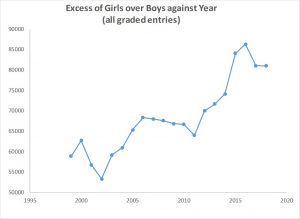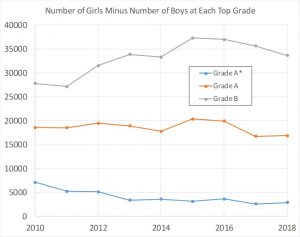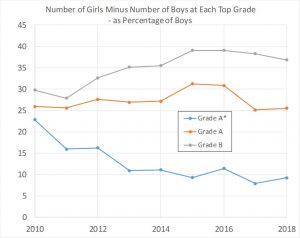Exactly one year ago to the day I posted “Boys Beating Girls in A-Levels? – Err, No” pointing out how grossly misleading were the newspaper headlines in respect of A Level results, e.g., in the Telegraph, “Boys beat girls to top grades for first time in 17 years”.
The statistical sleight of hand which is being pulled here relates to focussing on the percentages of each sex gaining top grades, as opposed to the absolute number of each sex gaining top grades – see the previous post for details.
The misinformation continues again this year. For example, the headline in today’s Times is, “A levels: Boys benefit from new regime as A*s soar and pass mark falls“, and tells us that, “boys outperformed girls at the top end” because they were “awarded a higher proportion of A*s and As for the second year in a row“. Whilst The Guardian informs us that, “Boys led girls in the top grades for the second year running. The proportion of boys who got A or higher was 26.6%, 0.4 percentage points higher than girls (26.2%)“.
You may find the absolute numbers hard to get hold of – the newspapers will not help you. I have used this source as the basis of the Figures below – which speak for themselves. Data is for England and Wales. (Click Figures to enlarge).
Salient points for 2018, across all subjects,
- There were 80,986 (22.2%) more graded A Level entries by girls than by boys;
- At grades A*, A and B the excess of girls over boys was 2,866, 16,890 and 33,638 respectively (a total of 53,394 across the three grades);
- At grades A*, A and B the excess of girls over boys, expressed as a percentage of boys, was 9%, 26% and 37% respectively.
Across all subjects, boys are not doing better than girls at any of the top three grades, nor for all grades together. The only positive feature of the results for boys is that the girls’ lead at the top A* grade is diminishing.
It’s almost as if the newspapers don’t want to expose the true position, as shown by Figures 1 to 4, below.
Figure 1: Excess of girls over boys (all subjects, all graded entries) – click to enlarge
Figure 2: Excess of girls over boys as a percentage of boys (all subjects, all graded entries)
Figure 3: Excess of girls over boys, grades A*, A and B separately (all subjects)
Figure 4: Excess of girls over boys as a percentage of boys, grades A*, A and B separately (all subjects)



